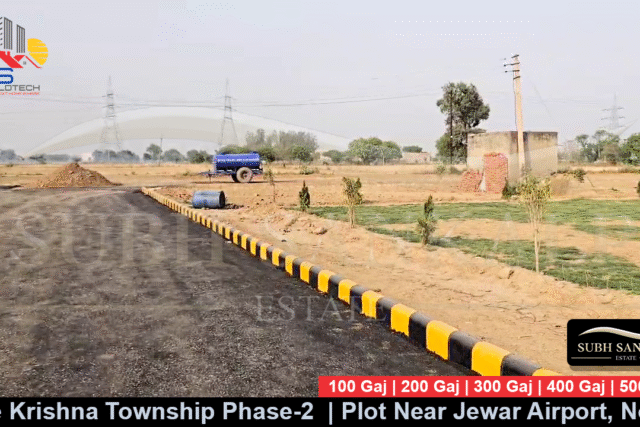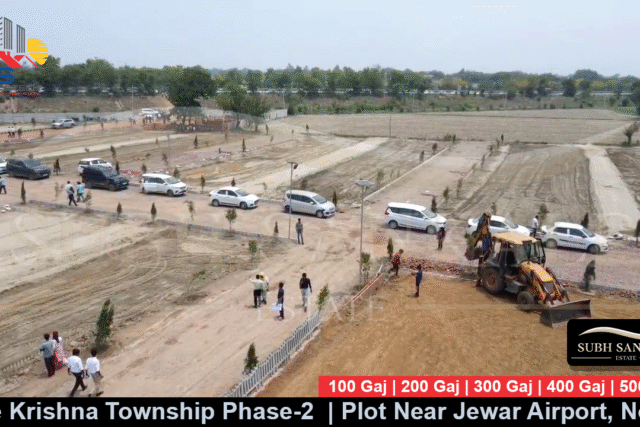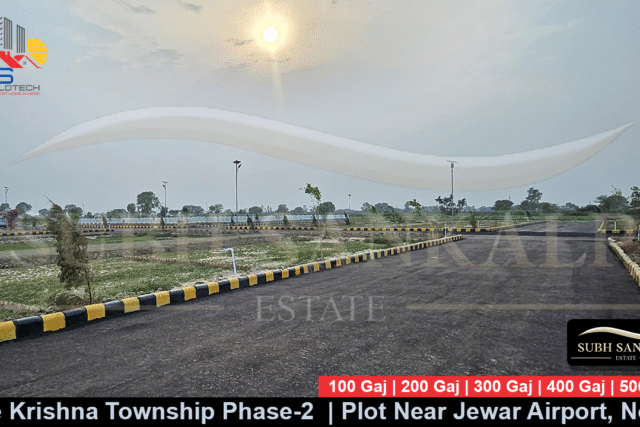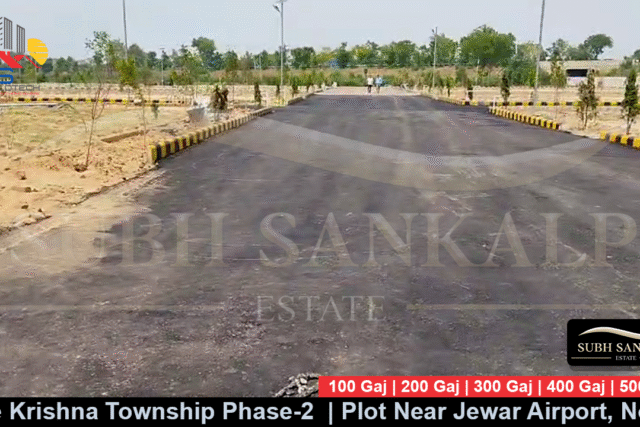A 300 Gaj Jewar Plot Rates – Hare Krishna Township Phase 2 in Jewar represents a significant step into the premium segment of residential land investment. This size is highly sought after for building spacious luxury villas and represents a substantial financial commitment. As the Noida International Airport moves from blueprint to reality, the pricing dynamics for large plots like these are evolving rapidly. This guide provides an in-depth analysis of the current rate structure, the key value drivers, and the long-term investment viability of acquiring a 300 Gaj plot in this transformative region.
1. Current Market Rates for a 300 Gaj Plot
The pricing for a 300 Gaj plot in Jewar is tiered, reflecting the varying levels of development, amenities, and proximity to key infrastructure nodes. The investment required is substantial and warrants a clear understanding of the market spectrum.
- Elite Sectors (Direct Airport Influence Zone): Plots in fully operational, premium sectors with wide paved roads, underground utilities, lush landscaping, and direct access to the Yamuna Expressway are at the top of the price range. Rates here are typically between ₹XX,XXX to ₹XX,XXX per Gaj.
- Established Developing Sectors (Near Future Infrastructure): Sectors with assured approvals and visibly progressing infrastructure—where clubs, parks, and commercial hubs are planned—offer a compelling value proposition. Rates in these areas are generally in the range of ₹XX,XXX to ₹XX,XXX per Gaj.
Therefore, the total capital outlay for a 300 Gaj plot in Jewar can range from ₹XX Lakhs to over ₹XX Crore, positioning it as a high-value asset for serious investors and those planning ultimate end-use.
2. Key Factors Influencing the Premium Per Gaj Rate
The price differential for a 300 Gaj plot is driven by a set of distinct, premium factors:
- Location Prestige and Exclusivity: Plots in gated enclaves with lower density, superior architectural controls, and proximity to proposed high-end social infrastructure (international schools, hospitals) command a significant premium. The address itself becomes a value proposition.
- Infrastructure Completeness and Quality: Beyond basic roads and electricity, the quality of finishing—such as the width of internal roads, the type of street lighting, the presence of dedicated jogging tracks, and the reliability of water and power supply—justifies a higher per Gaj rate.
- Developer Brand and Track Record: The premium associated with renowned national or highly credible local developers is pronounced at this plot size. Buyers are paying for the assurance of timely possession, legal safety, and a well-maintained community, which protects their large investment.
- Plot Specifics: A 300 Gaj plot that is a corner plot, has a park-facing frontage, or possesses a regular geometric shape is more valuable and priced higher than an interior plot with irregular dimensions.
- Economic Indicators and Speculative Demand: The influx of institutional investment and the announcement of ancillary projects like the Film City or MRO hub create a bullish sentiment, directly impacting the pricing of premium assets like 300 Gaj plots.
3. Investment Potential and Rationale for a 300 Gaj Plot
A 300 Gaj plot is not merely a larger asset; it is a different class of investment with unique advantages:
- Exponential Appreciation Potential: Large, premium plots are scarce. As Jewar matures, the supply of 300 Gaj plots will diminish, creating a scarcity-driven appreciation curve that often outpaces that of smaller plots. They are considered “land banks” with robust value growth.
- Ideal for Luxury Villa Development: This plot size is the perfect canvas for a 4-5 BHK luxury villa with expansive lawns, a swimming pool, a private garden, and ample servant quarters. It caters directly to the high-income demographic that the airport and associated industries will attract.
- Enhanced Flexibility and Lower Liquidity Risk: The owner has multiple options: build a dream home, develop a high-end service apartment/guesthouse for the corporate rental market, or hold the land as a long-term strategic asset. Its appeal to affluent buyers and NRIs ensures strong liquidity.
- Inflation Hedging and Wealth Preservation: A 300 Gaj plot is a tangible, finite asset that acts as a powerful hedge against currency devaluation and inflation. It serves as a core holding in a diversified investment portfolio, aimed at long-term wealth preservation and transfer.
4. Comprehensive Cost Breakdown for a High-Value Purchase
The acquisition of a 300 Gaj plot involves a substantial financial outlay, and a detailed cost breakdown is essential for accurate budgeting:
- Base Plot Cost: (300 Gaj x Agreed Premium Rate per Gaj). This forms the bulk of the investment.
- Stamp Duty and Registration: This government levy can represent a significant amount, typically 5% to 7% of the transaction value. For a plot in this price range, this alone can run into several lakhs of rupees.
- Goods and Services Tax (GST): If purchasing from a developer in a project under development, a 12% GST will be applicable on the instalment payments, adding considerably to the overall cost.
- Legal and Due Diligence Fees: Given the high value, engaging a top-tier legal firm for an exhaustive title check, verification of all approvals, and agreement scrutiny is non-negotiable. This cost is higher than for smaller plots but critical for risk mitigation.
- Additional Charges: Premium projects may have substantial one-time development charges, corpus funds for clubhouse maintenance, and premium membership fees for amenities, which must be factored into the total cost.
1. Why is the price per Gaj for a 300 Gaj plot sometimes higher than for a 100 Gaj plot in the same sector?
This is due to the premium plot premium. Larger plots are scarcer and offer more development potential. Developers and resellers often price them at a higher rate per unit area because they attract a wealthier clientele seeking exclusivity and larger homes, and because the total number of such plots in a sector is limited.
2. What is the typical payment plan for a high-value plot like this?
For a 300 Gaj plot, developers often offer structured payment plans. These usually involve a 10-20% down payment, followed by construction-linked or time-linked instalments spread over 2-4 years. Some also offer a significant lump-sum payment discount. For resale plots, the transaction is often shorter, with 80-90% payment demanded at the time of registry.
3. How does the potential Return on Investment (ROI) for a 300 Gaj plot compare to a commercial property in the same area?
A 300 Gaj residential plot offers potentially higher long-term capital appreciation, especially in the early stages of a development cycle like Jewar’s. Commercial property might offer immediate rental yields but can be more susceptible to economic cycles. The residential plot offers a “land bank” value, where the land itself is the primary appreciating asset, often with lower maintenance holding costs than a built commercial property.
4. Are there any restrictions on foreign nationals or NRIs purchasing a 300 Gaj plot?
NRIs can freely purchase residential plots in India under the Reserve Bank of India’s (RBI) automatic route. There are no restrictions on the size, including a 300 Gaj plot. However, citizens of Pakistan, Bangladesh, Sri Lanka, Afghanistan, China, and Iran require prior approval from the Reserve Bank of India.
5. Is the future appreciation of a 300 Gaj plot dependent on me building on it immediately?
Not necessarily. The primary driver of appreciation is the development of the surrounding infrastructure—the airport, roads, metro, and social amenities. While building a luxury property can significantly increase the total asset value, the underlying land value of a 300 Gaj plot is expected to appreciate robustly on its own due to the macro-development in Jewar. Building can be timed to align with personal needs or to capitalize on a strong rental market in the future.
















Leave a review for 300 Gaj Jewar Plot Rates – Hare Krishna Township Phase 2